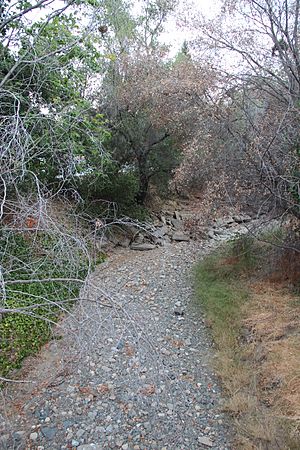Saratoga Creek facts for kids
Quick facts for kids Saratoga Creek |
|
|---|---|

A dry Saratoga Creek in 2015
|
|
|
Location of the mouth of Saratoga Creek in California
|
|
| Other name(s) | Arroyo Quito, Quito Creek, Campbell Creek, Big Moody Creek |
| Country | United States |
| State | California |
| City | Saratoga, Cupertino, San Jose, Santa Clara |
| Physical characteristics | |
| Main source | Saratoga, California, Santa Clara County, California 3,120 ft (950 m) 37°15′11″N 122°06′16″W / 37.25306°N 122.10444°W |
| River mouth | Guadalupe Slough south San Francisco Bay, Santa Clara, California 0 ft (0 m) 37°25′02″N 121°59′16″W / 37.41722°N 121.98778°W |
| Basin features | |
| Tributaries |
|
Saratoga Creek is a creek that flows north-northeast through Santa Clara County, California. It starts in the Santa Cruz Mountains and eventually reaches the San Francisco Bay. This creek is home to various plants and animals.
Contents
History of Saratoga Creek's Name
Saratoga Creek has had many names over the years! It was first known as Arroyo Quito. Later, it was called Campbell Creek. This name came from William Campbell, who built a sawmill in 1848. He also ran a stagecoach stop in 1852. His son, Benjamin Campbell, founded the town of Campbell in 1885.
Other old names for the creek included Big Moody Creek and San Jon Creek. Finally, in May 1954, the Board of Geographic Names officially decided on the name Saratoga Creek.
Where Does Saratoga Creek Flow?
Saratoga Creek begins high up in the Santa Cruz Mountains. It starts near Castle Rock Ridge at about 3,100 feet (945 meters) above sea level.
The creek flows for about 4.5 miles (7.2 kilometers) through forests. Much of this part is inside Sanborn County Park. It then travels about 1.5 miles (2.4 kilometers) through the town of Saratoga. After that, it flows for another 8 miles (12.9 kilometers) through busy cities like San Jose and Santa Clara.
How Saratoga Creek Changed Over Time
Today, Saratoga Creek joins San Tomas Aquino Creek before flowing into the Guadalupe Slough and then the south San Francisco Bay. But this wasn't always the case!
Long ago, San Tomas Aquino Creek and Calabazas Creek used to flow into Saratoga Creek. Saratoga Creek then flowed into the Guadalupe River. By 1876, engineers changed the path of these creeks. San Tomas Aquino Creek was made to flow directly into Guadalupe Slough. Calabazas Creek was also moved to flow directly into Guadalupe Slough. This made Saratoga Creek a tributary of San Tomas Aquino Creek.
Tributaries of Saratoga Creek
Saratoga Creek has several smaller streams that flow into it. These are called tributaries. The main ones are Booker Creek, Bonjetti Creek, and Congress Springs Creek.
- Bonjetti Creek has its own smaller tributaries: McElroy Creek, Todd Creek, and Sanborn Creek.
- Congress Springs Creek was also known as Congress Hall Creek. It was named after a famous resort called Congress Hall at Congress Springs. This resort attracted many tourists until it burned down in 1903.
Most of Saratoga Creek still has its natural shape. However, some parts have been changed by people. For example, some sections have walls built to control the water flow.
Animals and Plants of Saratoga Creek
Saratoga Creek is an important home for many different living things.
Fish in the Creek
Historically, steelhead trout used to swim from San Francisco Bay up Saratoga Creek to lay their eggs. People even fished for trout in the Congress Springs tributary in the late 1800s! In 1905, steelhead trout were still found in the creek.
Today, a barrier stops these fish from swimming up from the bay. However, rainbow trout that live in the stream all the time can still be found here. Scientists have checked their DNA and found that these trout are native to the area. They are not from fish farms.
Other native fish found in the creek include California roach and Sacramento sucker.
Beavers in the Past
Did you know that beavers once lived in the creeks around south San Francisco Bay? Scientists found a skull of a Golden beaver (Castor canadensis subauratus) in 1855. It was collected near Santa Clara, California, likely from Saratoga Creek when it was called Quito Creek. This shows that beavers were part of the creek's ecosystem long ago.
Plants Along the Creek
The upper parts of the Saratoga Creek area are covered with thick forests. You can find tall Coast redwood trees (Sequoia sempervirens) and Coast Douglas fir trees (Pseudotsuga menziesii var. menziesii). There are also areas with chaparral, which is a type of shrubland.
Near the water, you'll see trees like White alder (Alnus rhombifolia), Bigleaf maple (Acer macrophyllum), and California bay (Umbellularia californica).
Further downstream, along the lower parts of the creek, you can find many native plants. These include:
- Arroyo willow
- Box elder
- Fremont cottonwood
- Western sycamore
- Red willow
- Yellow willow
- Blue elderberry
- Coffeeberry
- Coyote brush
- Mule fat
Unfortunately, some non-native plants have also grown in these areas.


